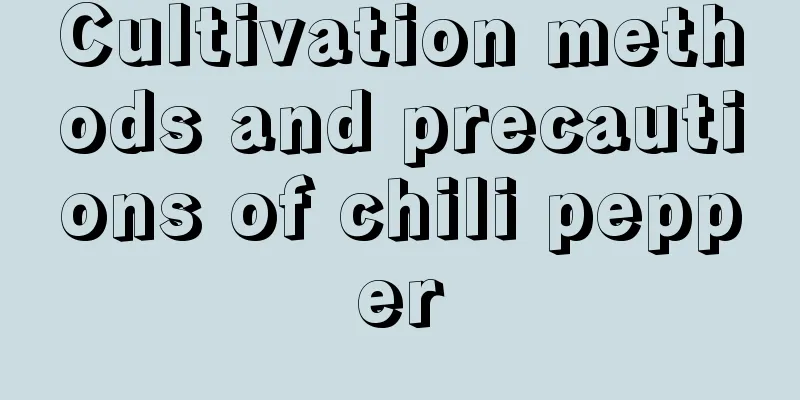Cultivation methods and precautions of chili pepper

1. Maintenance methods1. Soil: When breeding, you must choose soil suitable for its growth. The soil needs to be fine, without too large lumps, and also have good air permeability. Do not use soil that is too sticky. If you prepare the soil yourself, you need to disinfect it in advance. 2. Watering: It is drought-resistant, but at the same time it is very afraid of waterlogging, so it should be watered in small amounts during maintenance. If there is excess water in the soil, its leaves will easily fall off, and in serious cases it may even die. 3. Light: Chili pepper likes a growing environment with good light, and it can also accept a low-light environment. When planting, you must choose a good location and try to ensure sufficient light, which is beneficial to its growth. 4. Fertilization: In order to make it grow better, it is generally necessary to fertilize it every half a month or so, and you can apply organic fertilizer to it. During its flowering and fruiting period, it needs to be sprayed with some potassium dihydrogen phosphate. 2. Breeding techniques1. Seeding propagation: The propagation of chili pepper is mostly done by sowing, and you should choose seeds that are full enough. Before planting, put it in warm water and wait until the seeds turn white before planting. You can use the broadcasting method when planting, and cover with a thin layer of soil after sowing, otherwise it will be difficult to germinate. 2. Cutting propagation: It is also possible to use branches for propagation, but you must choose healthy branches. The substrate must also be clean. Do not use saline-alkali soil. Insert the branches into the substrate and adjust the temperature to 18-25℃ for easiest rooting. 3. Problem diagnosis and treatment1. Anthracnose: It is easy to occur when it rains a lot and the temperature is high. If it is not prevented and controlled in time, the yield will be reduced. The medicine should be used as soon as possible after the onset of the disease. You can use Aimu water-dispersible granules for prevention and treatment. 2. Pests: When there are pests on the chili pepper plants, it will not only affect the yield, but also hinder its normal growth, so you need to buy special and regular pesticides to spray them. IV. Other issues1. Can it be grown in potted plants? It can be grown in potted plants. When growing it in a potted plant, you should choose a pot of suitable size, and the diameter of the pot should be at least about 15-25cm. 2. Pruning: After harvesting the chili peppers, cut off their side branches. And also trim off some diseased and old leaves, so as to reduce unnecessary nutrient loss. |
<<: Cultivation methods and precautions of Changchun oilseed vine
>>: Orange Monroe cultivation methods and precautions
Recommend
How to water Phalaenopsis in winter
How to water in winter Phalaenopsis is a typical ...
What water should be used for golden diamonds?
1. Daily watering When watering the Golden Diamon...
How to care for hyacinths in soil and what are the precautions
1. How to maintain 1. Loose soil: For hyacinths g...
The meaning of asparagus fern
Origin of the name and its meaning Origin of the ...
When is the best time to sow Phlox?
Suitable time for sowing Phlox Phlox is an annual...
Causes and treatments of yellowing leaves of Jade Plant
1. Unsuitable soil Reason: The soil used for grow...
Can the dripping guanyin be transplanted in autumn? The leaves turn yellow after transplanting
1. Can the Dripping Guanyin be transplanted in au...
What to do with the newly cut green radish
1. How to grow hydroponics 1. Water use: It is be...
How to breed Xiuyan
1. Reproduction You can choose to cut off the hea...
The difference between cone and lithops
1. Different plant types The Conus and the latter...
How to make rice water fertilizer
1. Production method 1. Put the water used to was...
How to prepare plant nutrient soil at home (what are the commonly used raw materials for nutrient soil preparation)
How to prepare nutrient soil yourself How to conf...
What is the best fertilizer for fruit trees?
Time to fertilize fruit trees In winter, fruit tr...
Agave cultivation methods and precautions
1. Soil It is best to use loose, fertile and well...
How to fertilize Kalanchoe? Do these three things to absorb nutrients well!
1. Fertilizer selection: The Kalanchoe can be pla...









